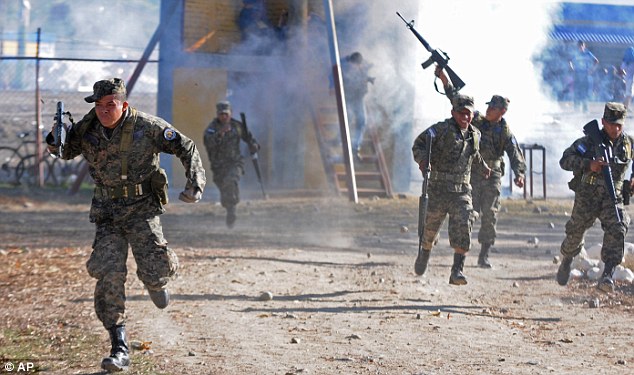The term ‘humanitarian crisis’ has been adopted by politicos of all stripes to describe the wave of unaccompanied minors flooding across the Rio Grande into the United States. That descriptor’s a shame, however, because it couldn’t be more inaccurate. Yet it’s allowing deportation advocates to claim a false moral high ground in the child migrant debate, while distracting from the true crisis that’s taking place thousands of miles southward.
If President Obama were serious about staunching the flow of immigrant children—if he were only willing to shut off the faucet—conservatives claim, the crisis would disappear, or at least begin to dissipate.
“We have a humanitarian crisis that President Obama has the ability to stop,” said Texas Gov. Rick Perry (R) on ‘Hannity’ July 10, while pushing for a hardline deportation policy.
“This humanitarian crisis will continue until the parents who paid thousands of dollars to smuggle their children north to the United States see plane-loads of them landing back at home,” added Sens. John McCain (R) and Jeff Flake (R) of Arizona in a press release on the 17th.
Their argument—which holds that the human tragedy experienced by Central Americans is avoidable via deportation—makes the conservatives look like bleeding hearts as well as pragmatists, and it makes liberals look like unintentionally cruel idiots.
But its moral element falls apart, when you realize the border is not the scene of a humanitarian crisis—not even partially—even though Republicans, as well as Democrats and the mainstream media, commonly accept that it is. Rather, the one, sole human tragedy befalling these children is occurring 800 miles southward in the ‘Northern Triangle’ of Central America. For many of them, what’s happening on the border is this tragedy’s sole respite.
Let’s examine, for a moment, the typical journey of the minors in question. In the nations from which they hail—usually Guatemala, El Salvador, and Honduras—life is nasty, brutish, and, often, short. In urban centers, gang violence is typically extreme, child torture, not uncommon. In the borderlands and mountains, ruthless criminal overlords control entire districts on the area’s bustling cocaine routes, and in many places—especially in Honduras, from where over 40 percent of these children are emigrating—it wouldn’t be unfair to adopt Noam Chomsky’s description of the place as a “failed murderous narco-state.”
According to the Congressional Research Service, almost half of unaccompanied minors immigrating to the US experienced violence at the hands of state actors or gangs, and more than a quarter were abused in the household. Earlier this year, Honduras’ chief of police, known as Le Tigre—(I couldn’t make this up)—essentially bragged to a reporter of his service in extrajudicial execution squads.
What adds a sense of acute desperation to this atmosphere of acute violence is that there’s little way for children to escape the violent ganglands in which they’re raised. In El Salvador, 55 percent of children live in poverty. In Honduras, this number is 67 percent.
So, as it now stands, you have a mass of desperately impoverished minors, suffering violence from all angles—the state, the thriving criminal sector, and the home. In other words, you have a true ‘humanitarian crisis’—one which is taking place thousands of miles from the United States.
I think it’s safe to say that the only real option for many of these youths is to get out. They do in great numbers, and this escape is, in of itself, anything but a tragedy. Exhibiting a sense of initiative, drive, and bravery that those camping outside DHS holding facilities and throwing rocks at school buses full of frightened child migrants could only dream of, tens of thousands cross the Guatemalan border into Mexico before hitching a ride atop trains to Chihuahua and Laredo. Around 800,000 total immigrants then make the clandestine journey into the US—90,000 of them children. About 500 total do die in the process—from drowning, exposure, car crashes, diseases, and the like—which might seem like a lot until you consider that about 360 of every 800,000 Americans will die of accidents or homicide every year. And a much higher percentage of persons practicing certain professions—such as forestry or fishing—will die of unnatural causes annually than will persons crossing the border.
The border situation, in other words, in not a humanitarian crisis, not even close. In fact, for most the borderlands are a place of great promise—and many children are actively looking for border patrol agents in order to enter into processing, and, at least for a few years, a whole new life.
Why is this distinction between the crisis in Central America and the non-crisis on the border important? you might ask.
It is admittedly rhetorical, but words matter. As it is now, our rhetoric has been twisted in some circles to make sending kids back to Honduras to be tortured and killed sound like an act of compassion. Admittedly, there are other factors to debate here—such as the sanctity of law and the potentially unfair manipulation of refugee regulations by Central Americans—and writers have debated them all ad nauseam from both sides. But let’s be perfectly honest about one aspect of this debate: there is absolutely nothing humane about sending kids back to their slaughter.
